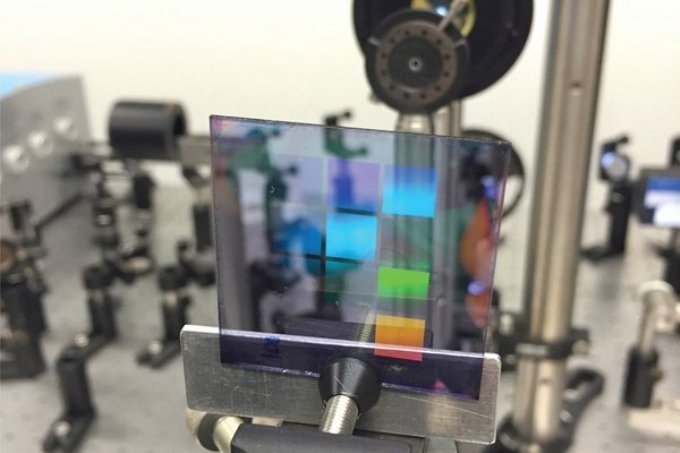Dec 18 2018
Scientists at the Eindhoven University of Technology (TU/e) have created a new kind of low-energy, nanoscale laser that is capable of shining in all directions.
 An experimental sample of the new laser. It contains ten patches that each have their own silver nanoparticle pattern. The colors on the sample are not the laser light (the laser is not on) but reflections, similar to the colors that can be seen on the surface of a compact disk. (Image credit: Alexei Halpin, Eindhoven University of Technology).
An experimental sample of the new laser. It contains ten patches that each have their own silver nanoparticle pattern. The colors on the sample are not the laser light (the laser is not on) but reflections, similar to the colors that can be seen on the surface of a compact disk. (Image credit: Alexei Halpin, Eindhoven University of Technology).
The omnidirectional light emission of the laser is caused by the introduction of something that is often highly unwanted in nanotechnology, that is, irregularities in the materials. The scientists envisage a wide range of possible applications, but before that, they first believe that their significant work will motivate others to further enhance it and thus provide a better understanding. The results of the study have been reported in the journal Physical Review Letters.
In science and technology, lack of control of the variables that establish a system’s response is often considered as a curse; however, what about a slight degree of disorder and imperfection? Irregularities and imperfections cannot be avoided in nanoscience because of the restricted level of control of nanofabrication processes. Disorder can possibly cause damage to nanosystems, but if it is well contained, it may not be an intruder after all and result in new physical ideas and applications.
The study has been published in the renowned journal Physical Review Letters. Researchers from TU/e and the Dutch Institute for Fundamental Energy Research (DIFFER) have explored the role of disorder and imperfections in nanolasers. By introducing a slight pinch of disorder, the team noticed a considerable change: the laser emits in all directions, and not in one particular direction.
In this context, the development of nanoscale lasers (smaller than the thickness of a single strand of human hair) is considered a highly active field of research. In a standard laser, every photon, or light particle, is “cloned” a number of times in a medium situated within a cavity (for example, two mirrors between which the photon moves to and fro creating other photons that have the same properties). This process is called light amplification by stimulated emission of radiation, or LASER for short. Often, laser emission is achieved by injecting an electrical current via the medium, or alternatively, a high-energy light is used to illuminate it. Lasing threshold is referred to as the minimum energy required for a laser to emit.
The so-called polariton laser is a different type of laser. Rather than working on the principle of cloning photons, the laser makes non-identical photons identical in relatively the same manner in which water vapor molecules—shifting in all directions with varied velocities—are condensed into one, single drop. Condensation of photons results in strong and directional emission characteristic of a laser. A major benefit of polariton lasers is that they possess a relatively lower lasing threshold, and as a result, they serve as excellent candidates for a wide range of applications.
Yet, there has been a significant issue with polariton lasers: they need to work at extremely low temperatures (like vapor condensation that occurs only when the temperature is decreased). However, if organic materials are used, polariton laser emission could be obtained even at ambient temperature. Last year, the Eindhoven team showed that it can achieve nanoscale polariton lasers that operate at ambient temperature, by utilizing metallic nanoparticles rather than mirrors as in standard lasers.
Now, the TU/e-DIFFER scientists have found a new type of polariton laser that contains a regular pattern of silver nanostripes enclosed with colored PMMA-polymer whose dye is composed of organic emitting molecules. Yet, the silver stripes intentionally have some degree of disorder and imperfection, and the emission from this non-perfect nanolaser is omnidirectional and is primarily established by the organic molecules’ properties. This outcome is not anticipated in the condensation framework because omnidirectional emission needs emissions from separate organic molecules rather than the collective emission usual for condensation. These demonstrations of omnidirectional emission set new boundaries toward the development of nanoscale lasers at ambient temperatures.
According to the investigators, their laser could be ultimately used in many different areas. The omnidirectional laser light is better defined and much brighter when compared to an LED. This is why it is an excellent candidate for microscopy lighting, which now utilizes LEDs. Laser imaging detection and ranging, or LIDAR for short, is another promising application. The present generation of LIDARs employs one or more lasers and a set of rapidly moving mirrors to cover wide areas to image remote objects. Moreover, an omnidirectional laser eliminates the need for the moving mirrors, thus considerably decreasing the complication. Furthermore, general illumination is also an option, stated lead research professor Jaime Gomez Rivas.
But the research is still very fundamental. We hope that our results will stimulate other researchers to improve them by further reducing the lasing threshold or increasing the range of emitted colors.
Jaime Gomez Rivas, Lead Research Professor, Eindhoven University of Technology.
Surface Photonics Group
The research team responsible for this study explores light-matter interaction improved by resonant structures, like structured surfaces and metallic nanoparticles. Intense light-matter coupling results in novel fundamental phenomena that can be leveraged to modify the characteristics of materials.
The team is part of the Photonics and Semiconductor Nanophysics capacity group at the Department of Applied Physics and of the “Institute for Integrated Photonics” of Eindhoven University of Technology (TU/e), and previously part of the Dutch Institute for Fundamental Energy Research DIFFER), where the experimental work in this study was carried out.